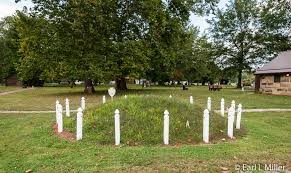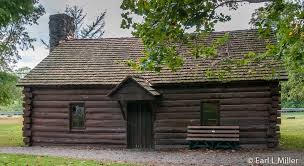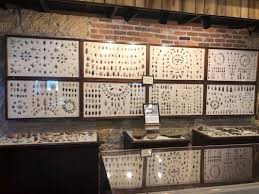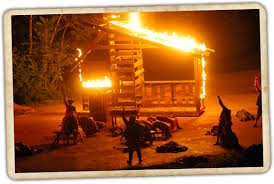Gnadenhütten Historical Park and Museum
Introduction
Text-to-speech Audio
Images
The mound that was later made after people returned to Gnadenhutten and were unsure of what to do with the remains.

The sign that is at the entrance of the historical park, an explanation of the "Day of Shame" is printed on it.

The obelisk marker that is in memorial of the Christian Delawares who were killed at Gnadenhutten..

The replica of the Mission at Gnadenhutten.

Arrowheads that were found locally that are now in the Museum at the Historical Park.

Paul Green's "Trumpet in the Land" at the Schoenbrunn amphitheater.

Backstory and Context
Text-to-speech Audio
Gnadenhutten was one of the Moravian mission towns founded by German missionary David Zeisberger, and the Indian peoples that lived there belonged primarily to the Delaware tribe. 1782 was a time in which Indians and white soldiers did not get along, and as a result, there were many Indian attacks carried out by hostile tribes on the white settlements. Although the Gnadenhutten Delawares were a peaceful group, Some of the militiamen in Wheeling, including Col. David Williamson believed that the hostile attacks were coming from tribes in the Tuscarawas Valley. As a result, Williamson was put in charge of an expedition to "punish" the hostile Indians.
Williamson's expedition began immediately the next day, which was March 5th, 1782. The mission town of Gnadenhutten was actually empty at the time of these Indian attacks, but unknowing of the expedition to the mission towns by the Pennsylvania militiamen, a group of 150 Delawares made the trip back to the Tuscarawas Valley to salvage the crops that they may have left after the winter had passed. Split into 3 groups, 50 of these Delawares went to Gnadenhutten, 50 to Salem, and 50 to Schoenbrunn.
As the Delawares were collecting their crop, a group of hostile warriors arrived at the village upon return from their raids in upper Ohio. Abraham, the leader of the Delawares in Gnadenhutten, explained that they were not welcomed at the peaceful town. The warriors left, but not before trading some with the Moravians. Some of the Delawares feared that Americans might be following the hostile party, but Abraham assured them that even if the Americans did come, they would know that the Delawares were peaceful and Christian.
By the time the harvesting was finished it was March 7th. Abraham suggested that the tribe leave and head back to Captives' town on the Sandusky the following day. That morning, Williamson's army had already come across something sickening after crossing the Ohio river: two bodies that had been obviously left for them to discover. They were impaled, scalped, and were nude. The two bodies were Jane Wallace, and her infant daughter Sarah. Robert Wallace was the husband and Father of the two and he just so happened to be in Williamson's 100 man militia.
The next morning, Williamson sent a group of men out under Captain Charles Bilderback. Bilderback was obvious in his intent to kill for he murdered the first Delaware he saw, a Christian named Jacob who was alone. Williamson and the rest of the men arrived at Gnadenhutten and approached the 48 Delawares who were at work in the field across the river. Williamson approached Abraham and told him a lie that consisted of he and his fellow Delaware being escorted to Fort Pitt to be protected from the hostiles as well as other American troops. This convinced Abraham's people to surrender their weapons and go back to the village where the American soldiers were waiting on them. It's not impossible that the Moravians could have been taken to Fort Pitt, but then Robert Wallace made a discovery that changed everything. Robert saw that one of the young Delaware women was wearing his wife Jane's dress. This of course led the militiamen to believe that these were the Indians that were hostile and that had killed his young wife and daughter.
The Moravians tried to explain that the articles of clothing had come from the warriors that had passed through the day before, but the militiamen didn't buy it. At once the situation became hostile and Williamson ordered all of the Delawares to death. All of them, including the women and children were bound at the wrists and ankles and separated into two buildings; the men and boys into the mission and the women and children into the cooper's shed. Williamson gave the Moravians the night to make peace with God and explained that the execution would take place the following morning.
The Moravians spend the entire night praying, and at daylight, Bilderback was given the honor of starting the executions. He chose Abraham as his first scalp. Each boy and man was struck in the back of the head with a cooper's mallet, and then scalped. In the cooper's shed, the women and children were tomahawked to death by the remainder of the militiamen. The two buildings were set on fire with the bodies inside of them. Between the Gnadenhutten Delawares and the one brought in from Salem, 92 men, women, and children were massacred at the village on March 8th, 1782.
Sources
Eckert, Allan W. That Dark and Bloody River.
https://www.nanmillertimes.com/may-14-a-clash-of-cultures.html
https://www.revolutionary-war-and-beyond.com/christian-indians-killed-gnadenhutten-massacre.html
https://www.nanmillertimes.com/may-14-a-clash-of-cultures.html
https://www.nanmillertimes.com/may-14-a-clash-of-cultures.html
https://www.mapquest.com/us/ohio/gnadenhutten-historical-park-and-museum-408404055
http://www.trumpetintheland.com
